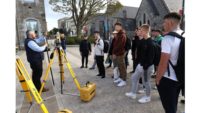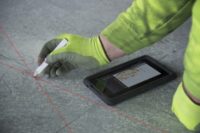The good news is: faster than an expensive total station could do it; much faster than old-fashioned tape and chalk could do it; and certainly faster than the customer expects. And not only faster, but more accurately too.
Contractors across the country are improving their competitiveness and lining up more jobs by utilizing new laser technology that allows them to immediately find layout points for interior wall construction.
Using Lasers in a New Way
Construction lasers have been on the market for some time. Line lasers have traditionally been used for point transfer, 90- or 180-degree layout and alignment. They are tremendous tools for improving quality and accuracy in chores like confirming cabinetry levels, acoustical ceiling installation, and other interior fit-out tasks. Red lasers are the most common but green beam is now being utilized for better visibility.
Some traditional laser applications include (for point and lines):
- Short run vertical alignment
- Squaring & layout of partitions, walls, tile floors
- Plumb reference and point transfers for door frames, lighting locations
- Level reference for leveling counter tops, windows, chair rails (interior fit-out)
However, never before have construction professionals been able to find a point in space, based on architectural drawings’ written layout. New laser “X-marks-the-spot” technology is now available.
In other words, aligning existing interior walls and fittings is what most laser solutions do. Locating the points for the layout of the walls in the first place is the focus of this new laser technology.
The new technology utilizes a set of two lasers tethered wirelessly to an Android tablet loaded with software that reads the architectural drawings. With a finger tap to the screen of the tablet, the lasers can locate the designated point in five seconds with an accuracy of 1/8 inch.
The system is available in both red and green beam lasers for safe viewing in a variety of environments. The “X-marks-the-spot” of the intersecting fan beams makes the point markable on the floor and simultaneously on the ceiling.
Complex Jobs Made Simple
First, the architectural files are loaded directly into the tablet controller that communicates with two green beam lasers, slightly elevated on short tripods. Then, set up a baseline scale for the specific site using the software and prompts. Once that’s done, locating a point on the floor is no more complicated than tapping the drawing on the tablet screen. The lasers will make an “X” within a few seconds at the exact location on the floor and ceiling, ready for marking.
Rounded or uneven surfaces are no problem, because the laser fan beams are determined by the same kind of radial encoders used in total stations, and run from floor to ceiling. So, if the layout point is to be found on a curve or a slope, it requires no human calculation at all—the “X” will still mark the spot accurately, every time.
“Our first job with the QML800 happened to be a complicated curved ten-tier ceiling,” says Rob Grassing of Grassing Drywall and Acoustics, Ltd., a Canadian firm specializing in high-end commercial drywall installations.
“After training on the QML800, which took 30 minutes, we did the same curved ten-tier ceiling job with one man in only four hours—a savings of 28 man hours,” Grassing says.
No More Compound Errors
There’s not a contractor in the world who hasn’t lost sleep over the issue of compounding errors — a marking mistake turning into an error that is carried forward to the next wall, and the next, compounding over distance and bringing other trades’ work into the mix as well. Since walls are normally dimensioned from previous measurements, it’s not an uncommon issue.
The two-laser set, however, marks an “X” within 1/8 of an inch, every time. No human calculations are necessary and no reading errors are possible. Ever more common complicated design elements such as circles, arcs, and serpentine curves are no problem. And, complex soffits are now headache-free. A ceiling fixture completely out of sync with the floor grid can be handled with ease.
Clutter Conflict Begone
Walls & Ceilings did a survey in May of 2014 that showed that workers spend an average of 64 minutes a day looking for material on a site and 34 minutes a day moving material around at the job because it’s set down in the wrong place, often in the way of other teams’ work. That’s more than 20 percent of a worker’s day. But it’s not really surprising. As soon as concrete is poured, and usually before any wall layout is complete, crews from a variety of trades start stacking material and staking out space.
Using the “clutter buster” feature of a laser system can eliminate most of this problem. By capturing the laser “X” above the clutter and translating the point to the floor with a laser plumb pointer—instead of shifting material around—work crews can move right past and over it. Similarly, the “column buster” function provides a quick workaround so that columns no longer block location points either.
Of course, when the wall layout is done so quickly that the mechanical and electrical teams have not yet set out their materials, it makes for an easier job for everyone and a more efficient workspace for all.











Report Abusive Comment